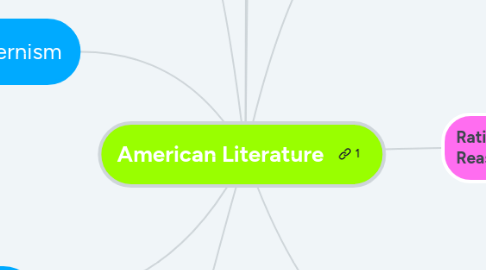
1. Contemporary“Postmodernism”
1.1. 1950-present Korean War Vietnam War
1.1.1. Influenced by studies of media, language, and information technology
1.1.2. Sense that little is unique; culture endlessly duplicates and copies itself
1.1.2.1. Alice Walker, Wallace Stevens, E. E. Cummings, Maya Angelou, Anne Sexton, James Baldwin, Richard Wright, Sandra Cisneros, Amy Tan
1.1.3. New literary forms and techniques: works composed of only dialogue or combining fiction and nonfiction, experimenting with physical appearance of their work
2. Transcendentalism“The American Renaissance”
2.1. 1840-1860Abolitionist, Utopian, and Women’s SuffrageMovements
2.1.1. Everything in the world, Including human beings, is a reflection of the Divine Soul
2.1.2. People can use their intuition to behold God’s spirit revealed in nature or in their own souls.
2.1.3. Self-reliance and individualism must outweigh external authority and blind conformity to tradition
2.1.3.1. Ralph Waldo Emerson (Nature, “Self-Reliance”), Henry David Thoreau (Walden, Life in the Woods).Louisa May Alcott (Little Women)
3. Harlem Renaissance“The Jazz Age”
3.1. 1920-1940“The New Negro Movement”Prohibition
3.1.1. Black cultural movement in Harlem, New York
3.1.2. Some poetry rhythms based on spirituals, and jazz, lyrics on the blues, and diction from the street talk of the ghettos
3.1.3. Other poetry used conventional lyrical forms
3.1.3.1. James Weldon Johnson, Claude McKay, Countee Cullen, Langston Hughes (poetry), Zora Neale Hurston
4. Modernism
4.1. 1900-1950 World War IThe Great DepressionWorld War I
4.1.1. Sense of disillusionment and loss of faith in the “American Dream”: the independence, self-reliant, individual will triumph.
4.1.2. Emphasis on bold experimentation in style and form over the traditional.
4.1.3. Interest in the inner workings of the human mind (ex. Stream of consciousness).
4.1.3.1. Lorraine Hansberry (A Raisin in the Sun), F. Scott Fitzgerald (The Great Gatsby), William Faulkner (“A Rose for Emily”). Eudora Welty(“A Worn Path”),Robert Frost(poetry), T.S.
5. Realism
5.1. 1850-1900 Civil War Reconstruction
5.1.1. Feelings of disillusionment
5.1.2. Common subjects; slums of rapidly growing cities, factories replacing farmlands, poor factory workers, corrupt politicians
5.1.2.1. Mark Twain (Huckleberry Finn), Jack London(Call of the Wild, “To Build a Fire,”)Stephen Crane(“The Open Boat”), Ambrose Bierce (“An Occurrence at Owl Creek Bridge”),Kate Chopin(“Story of an Hour,” The Awakening)
5.1.3. Represented the manner and environment of everyday life and ordinary people as realistically as possible (regionalism)
5.1.3.1. Sought to explain behavior (psychologically/socially)
6. Native Americans
6.1. Arrived 40,000 -20,000 B.C
6.1.1. Oral literature: epic narratives, creation myths, stories, poems, songs.
6.1.2. Use stories to teach moral lessons and convey practical information about the natural world.
6.1.3. Deep respect for nature and animals
6.1.4. Figurative language/parallelism
6.1.4.1. Cyclical world view
7. Puritanism
7.1. 1600-1800First “American” colonies established
7.1.1. Wrote mostly diaries and histories, which expressed the connections between God an their everyday lives.
7.1.2. Sought to “purify” the Church of England by reforming to the simpler forms of worship and church organization described in the New Testament
7.1.2.1. Saw religion as a personal, inner experience.
7.1.2.2. Believed in original sin and “elect” who would be saved
7.1.3. Used a plain style of writing
7.1.3.1. William Bradford(“Of Plymouth Plantation”), Anne Bradstreet (poetry), Jonathan Edwards (“Sinners in the Hands of an Angry God”), Edward Taylor (“Huswifery”)
8. Romanticism
8.1. 1800-1860 IndustrializationWar of 1812California Gold Rush.
8.1.1. Valued feeling, intuition, idealism, and inductive reasoning.
8.1.1.1. Placed faith in inner experience and the power of the imagination.
8.1.2. Shunned the artificiality of civilization and seek unspoiled nature as a path to spirituality
8.1.2.1. Championed individual freedom and the worthof the individual.
8.1.3. Saw poetry as the highest expressionof the imagination.
8.1.4. Dark Romantics: Used dark and supernatural themes/settings (Gothic style)
8.1.4.1. Washington Irving (“Rip Van Winkle”), Emily Dickinson (poetry), Walt Whitman (Leaves of Grass), Edgar Allan Poe (“The Raven”), Nathaniel Hawthorne (The Scarlet Letter)
9. Rationalism “The Age of Reason”“The Enlighten-ment"
9.1. 1750-1800Revolutionary War
9.1.1. Mostly comprised of philosophers, scientists, writing speeches and pamphlets.
9.1.2. Human beings can arrive at truth (God’s rules) by using deductive reasoning, rather than relying on the authority of the past, on religious faith, or intuition.
9.2. The Constitution,The Bill of Rights, and The Declaration of Independencewere created.
9.2.1. Benjamin Franklin (Autobiography), Patrick Henry (“Speech to the Virginia Convention”), Thomas Paine (“The Crisis”), PhyllisWheatley (poetry)
